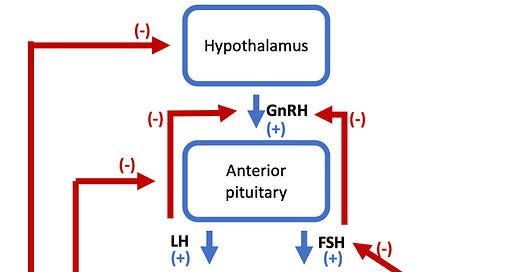In Part 1 of this topic, we covered total/free testosterone, SHBG, DHT, and Estradiol.
In Part 2, we’re going to cover how these are controlled by the endocrine system via the hypothalamus-pituitary-gonadal (HPG) axis, and various ways that this axis can be influenced. At the end of this post, I’ll summarize the ways that you can optimize your HPG axis.
Overview of the HPG Axis
Hypothalamus. Everything starts with the hypothalamus, which is a part of the brain that releases Gonadotrophin-Releasing Hormone (GnRH) in a pulsatile fashion into a portal vein system that flows down to the pituitary gland.
Above image shows the neurons in the hypothalamus that release GnGH through the portal circulation that flows down to the anterior pituitary. Source: https://openbooks.lib.msu.edu/neuroscience/chapter/hpg-axis/
Anterior pituitary. This is the front (anterior) part of the pituitary gland, which is a gland in the brain that responds to GnRH by producing the two gonadotropins, Lutinizing Hormone (LH) and Follicle Stimulating Hormone (FSH).
Gonadotropins. These are released into the blood stream and have the following functions:
LH stimulates the Leydig cells in the testes to produce testosterone.
FSH stimulates the Sertoli cells of the testes to produce sperm.
Feedback control of the HPG Axis
The body primarily uses a system of negative feedback to regulate the HPG axis.
This means that higher testosterone levels result in a stronger negative signal on both the hypothalamus and anterior pituitary to produce less GnRH and LH, which decreases the level of testosterone until everything is in equilibrium.
LH and FSH from the anterior pituitary will both also provide negative feedback on the hypothalamus to produce less GnRH.
Additionally, the Sertoli cells produce a hormone called inhibin-B, which provides negative feedback to the anterior pituitary to produce less FSH.
There are also other hormones that provide negative feedback at varying levels on the HPG axis, such as DHT, estrogen, prolactin, progesterone and cortisol.
Keep reading with a 7-day free trial
Subscribe to BowTiedLoon’s Newsletter to keep reading this post and get 7 days of free access to the full post archives.



